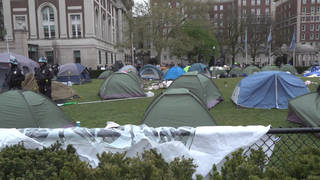
Related
Guests
- Jack Spadaromining engineer who has devoted his life to the safety of miners. He was head of the National Mine Health and Safety Academy (MSHA), a branch of the Department of Labor, which trains mining inspectors. He’s been working in federal regulatory agencies for almost 30 years. He was threatened with losing his job at MSHA after blowing the whistle on what he called a whitewash by the Bush administration of an investigation into a major coal slurry spill in 2000.
- Hillary Hostacampaigner with the West Virginia-based Coal River Mountain Watch.
- Ken Ward Jr.staff writer for the Charleston Gazette in West Virginia. He wrote an award-winning series of articles for the paper about coal-industry abuses in West Virginia, revealing that state regulators routinely ignore the law when they issue mountaintop removal permits.
Fourteen miners have died in a span of three weeks at mines in West Virginia. On Capital Hill Monday, David Dye, the Acting Assistant Labor Secretary For Mine Safety & Health, walked out of a hearing on mine safety before he could answer further questioning and hear from other witnesses. We speak with Ellen Smith, editor of Mine Safety and Health News. [includes rush transcript]
The bodies of two miners were found Saturday night following a fire inside a mine in the town of Alma. The Alma mine, which is owned by a subsidiary of Massey Energy, had been cited at least 12 times for violations involving fire equipment since June. The Alma deaths come just weeks after 12 miners died at West Virginia’s Sago mine. More miners have already died in the state in 2006 than in any year over the past decade. In response, on Monday, the West Virginia state legislature unanimously passed a bill aimed at improving mine safety. The measure would require miners to be equipped with wireless devices and additional oxygen tanks in case of an emergency that would trap them underground.
Meanwhile, on Capital Hill, the Senate Appropriations committee held a hearing on mine safety on Monday. The committee first heard from David Dye — Acting Assistant Labor Secretary For Mine Safety & Health. Under questioning, Dye could not explain why it took officials with the Mine Safety and Health Administration (MSHA) two hours to learn of the explosion at the Sago mine. At the end of his testimony, Dye got into an exchange with Republican Senator Arlen Specter over Dye’s announcement he had to leave the hearings early. After Dye left the hearings, Specter later said he could not recall ever seeing such a departure. The committee then heard from Cecil Roberts, President of the United Mine Workers of America.
- Ellen Smith, owner and editor of Mine Safety and Health News. She has been covering mining-related issues since 1987 and has won 17 journalism awards for her reporting, including the Society of Professional Journalists Sigma Delta Chi Award and the National Press Club Award for Newsletter Journalism. She is on the line from Mendon, New York.
Transcript
AMY GOODMAN: At the end of his testimony, Dye got into an exchange with Republican Senator Arlen Specter over Dye’s announcement he had to leave the hearings early. This is Senator Specter.
SEN. ARLEN SPECTER: Mr. Dye and Mr. McKinney, I’m advised that you would like to leave. Your presence will be required here for at least one more hour while we move ahead with the next panel. Questions may arise, and we want you here to answer the questions. We’ve assembled four senators who — well, they need your responses.
DAVID DYE: Senator, we’ve still got a mine fire going. We have a rescue team that’s in the Sago Mine. They have another mine fire — which no one was hurt — burning in Colorado. We have really urgent matters that we need to go back to attend. We’ve been diverted dealing with these matters. We were happy to prepare for the hearing, but we really need to get back and attend to all this. There’s 15,000 mines in the United States, and we’ve got some really pressing matters.
SEN. ARLEN SPECTER: Well Mr. Dye, I can understand the press of your other business. It may well be that some of the senators here have other pressing matters, too.
AMY GOODMAN: Minutes later, Dye left the hearing. Specter later said he couldn’t recall ever seeing such a departure. The committee then heard from Cecil Roberts, President of the United Mine Workers of America.
CECIL ROBERTS: I realize that this may be getting in an area that may offend some people, but in 1969, Mr. Chairman, Congress decided that this industry was incapable of policing itself and established MSHA as an independent body to protect the coal miners of the United States of America. And in 2001, we put the coal industry in charge of this agency, and we have submitted 17 rules that were withdrawn in 2001 or later that would have protected coal miners in the United States of America. And there are other issues that we could raise with you today, but I realize my time is up. I did not want to leave here with that on my heart and on my mind. Thank you.
AMY GOODMAN: Cecil Roberts, head of the United Mine Workers of America. We’re joined now by Ellen Smith. She is the editor of Mine Safety and Health News. Ellen, I wanted to ask you about — well, some of these facts. The Washington Post during the past five years, the number of mines referred to the Justice Department for criminal prosecution dropped steadily. Meanwhile, inspectors who sought to impose large fines on coal companies have seen those penalties whittled down by agency negotiators and administrative law judges. Last year, the operator of an Alabama coal mine where thirteen miners were killed saw its fine reduced from $435,000 to $3,000. And the Charleston Gazette is reporting that mining deaths in Alma, West Virginia — the two over the weekend — may have occurred, in part, because of a controversial new rule put in place by the Bush administration that allowed mines to use the conveyor belt area as a main source of oxygen for underground workers. The mining industry had long sought the rule change, but mining experts feared it would lead to an increase in fires. Your response?
ELLEN SMITH: Well, okay, let’s deal with the issue of penalties and fines. The case where the penalties were dropped from $435,000 down to three thousand and something is the Jim Walter resources case; and in that case, the judge said that MSHA simply didn’t make their case for the penalties. A lot of the penalties were issued for alleged dust violations, but MSHA couldn’t prove it, and the reason they couldn’t prove it is because, after the explosion occurred at the Jim Walters mine, they had to flood the mine to put out the fire; and the mine was actually flooded for 40 days. So evidence was destroyed, and the judge said that MSHA just couldn’t make its case. That same judge who was — the judge is David Barbour, has, in fact, raised penalties on other operators when he felt that MSHA’s civil penalty was not high enough. So, I just really want to clarify that.
Now, on the issue of criminal proceedings, I did have an Assistant U.S. Attorney tell me that he was not getting the criminal referrals from this administration as he had in the past. He said that criminal referrals from MSHA are pretty much nonexistent. Now, it doesn’t mean that if he sees a case, he couldn’t ask for criminal referral — they have the right to do that — but he said that he’s just not getting any referrals from MSHA.
On the issue of — that they questioned Dye on why was it — why did it take two hours for MSHA to find out about the accident, that, in fact, is not MSHA’s fault. It is up to the mine operator to immediately report an accident. And the words in the regulations are “immediate,” and generally that means within a half hour. And the bottom line is that the mine operator did not call MSHA until 8:30 that morning, almost two hours after the explosion occurred. So — but on the other issue of Secretary — Assistant Secretary Dye walking out, it’s just unheard of. And I have to say that the press community was certainly shocked by his actions.
AMY GOODMAN:And we have to point out that he was questioned by Republican Senator Arlen Specter.
ELLEN SMITH: That’s right. That’s right. And there was some other information that came up in the hearing that really was misinformation. Dye told one of the senators — they were asking: Why do mine operators have to be present during the questioning of miner witness interviews, that miners may be intimidated by the mine operator’s presence in the interview room? And Assistant Secretary Dye told the Senate panel that it’s a Mine Act requirement that the mine operator be part of the investigation and be in the room. In fact, it is not a Mine Act requirement. There is nothing in the Mine Act that says that the operator shall be present during witness interviews. What the Mine Act states is that the mine operator has to conduct its own separate interview, separate from MSHA, but there’s nothing in the act that says the operator has to be present when witnesses are questioned about an accident. Another senator did a follow-up question with Ben Hatfield on that very subject — Ben Hatfield, the President of International Coal Group who owns the Sago Mine — and Ben Hatfield said the same thing, that the Mine Act requires operators to be present. And your audience really needs to know that that is not a requirement under the Mine Act or under MSHA regulations.
AMY GOODMAN: Ellen Smith, I also wanted to ask you about this AFL-CIO analysis that the Bush Administration cut 170 positions from MSHA, from the Mine, Safety, and Health Administration and has not proposed a single new mine safety standard or rule during — well, throughout the Bush Administration?
ELLEN SMITH: Well, actually, that’s not quite accurate. There are new diesel regulations in place, and there’s noise regs and dust. Now, they did withdraw many, many rules, and, in fact, they did withdraw rules that would have saved these miners. In October ’99, we had a proposed rule to revamp the whole mine rescue team system, because everyone saw back then — and it was a general consensus between labor and industry — that the current mine rescue team structure was not working. In September 2002, MSHA said that it was withdrawing this item and plans to evaluate non-regulatory alternatives.
The other issue that would have helped the miners in the latest Aracoma Mine conveyor belt fire was in December 1992, there was a proposal for flame-resistant conveyor belts. And, in fact, conveyor belt manufacturing companies had been working on developing a newer type of flame-resistant conveyor belt. That was also withdrawn in July 2002 with no explanation. It just said MSHA has withdrawn this item. And part of that conveyor belt rule was that it would require mine operators to purchase the improved conveyor belts after one year after being published in the federal register, and I just can’t help but believe that that was withdrawn because of the expense.
AMY GOODMAN: Ellen Smith, we just have 20 seconds. I want to ask you about United Mine Workers. We just played a quote of Cecil Roberts. But what about their role? These are non-union mines?
ELLEN SMITH: These are non-union mines, and generally we can say that union mines are safer because the mine workers are not afraid to complain. They’ve got the backing of the union, and it is highly unlikely that they would be fired for making a complaint about safety and health conditions in their mine.
AMY GOODMAN: Ellen Smith, thanks for joining us, editor of Mine Safety and Health News.












Media Options